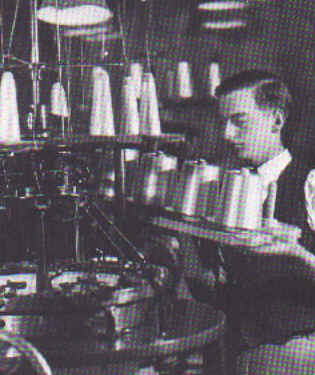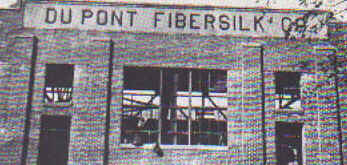|

The Rayon Years
 As many will know, the Old
Hickory site is older than 75 years. However, the record keepers
consider the date that rayon began production, January, 1925, as the
official date of the beginning of the DuPont-Old Hickory site.
The beginning and end of rayon stands testimony to the Old Hickory
site's ability to continually re-invent itself. As many will know, the Old
Hickory site is older than 75 years. However, the record keepers
consider the date that rayon began production, January, 1925, as the
official date of the beginning of the DuPont-Old Hickory site.
The beginning and end of rayon stands testimony to the Old Hickory
site's ability to continually re-invent itself.
In a special publication in 1950 noting 25 years of rayon
production at Old Hickory, the observation was made that the story of
rayon had a beginning and a middle, but no end. The demise of
rayon was in a future "too remote to foresee."
There was an end to DuPont's production of rayon, of course, but
not before the product, the plant, and the people at Old Hickory had
established a record of highest quality that has carried into
today. Accomplishments of Old Hickory rayon were important to
the growth of the DuPont Company. They resulted in a better life
including a higher standard of living for thousands of Middle
Tennesseans. And, on another level, for many, many people
the rayon plant was destined to become a large part of their daily
lives and in later years, their memories. Rayon was made for
more than 36 years here, for many an entire working career, and it
will not be forgotten.
Rayon plant 1 started production in January 1925, only nine months
after ground was broken for plant construction, and plant 2 began the
following December.
The first year's production amounted to 2.1 million pounds, and
production rose to a peak of 52 million pounds in 1951. All
told, over one billion pounds of textile and industrial rayon were
produced at this location.
In the early years, most rayon output went into low-priced
underwear and hosiery. the thought of producing woven fabrics
from "artificial silk" was then mere fancy.
Those early yarns had neither the strength to withstand the weaving
processes, nor the uniformity and quality for making fabrics that
would compete with trade demands. This condition did not last
long. Determined technical people with the aid of operating
organizations made rapid strides in gaining know-how and introducing
process improvements. As progress was made in such areas as
improving the dyeing properties of the yarns and increasing strength
of the product, Old Hickory yarns were gradually introduced into the
weaving trade. These improvements proved advantageous for this
site through the years, particularly during the depression.
Although business declined in this period, most spinning machines were
kept running and layoffs were not as long lasting as in most other
businesses throughout the country.
In the 1940s rayon surpassed wool and silk in fiber consumption in
the United States. It came to be used in the finest of fabrics
and the choicest of garments, with applications in ties, evening
dresses, gloves, raincoats, draperies, ribbons and exquisite
upholstery fabrics. Rayon had evolved far beyond the "artificial
silk" of 1925.
Despite many advancements in the product, a declining sales pattern
began in 1952 which continued until the plant was closed down.
In 1953 it became apparent that textile rayon would never again enjoy
the populairty of previous years. Furthermore, by this time, Old
Hickory rayon was not as competitive as it had been due to quality and
package improvements made by other rayon producers in up to date
plants.
It was at this point that Textile Fibers management began a series
of studies directed toward preserving Old Hickory as a plant
site. One major objective was to minimize any possible negative
effect on employees, many of whom had been with the DuPont Company
since rayon startup. In addition, considerable attention was
given to developing plans which would restore DuPont textile rayon to
a better competitive position. By early 1956, a plan had been
developed which appeared attractive from both personnel and economic
viewpoints. This program proposed to:
- Modernize the rayon plant to improve overall quality and extend
its useful life as long as possible.
- Select appropriate new products for the site which would
supplement and gradually replace rayon. "Dacron"
was tentatively visualized at this time.
Demand for rayon continued low, and it was soon decided to
consolidate all production into plant 1. Part of the plant 2
unit was shut down in late 1957 and the remainder in 1958. The
overall modernization-consolidation program for the remaining plant
was completed by mid-1958, approximately the same time that employees
learned they would soon be producing the new fiber Dacron.
During this period (1956-1958) wage roll employment dropped from 2,200
to 1,300, but the quality improvements temporarily stabilized sales
and aided job security for the remaining employees.
Employment was relatively stable through 1959. Late that year
and in early 1960 some 200 wage roll employees were
recalled to begin training for Dacron and DMT startups.
In August 1961, with Dacron well into production and the future
again brightening, Old Hickory people manufactured their last
rayon. An era had ended.
From Our Old Hickory Heritage -
published by the DuPont Old Hickory Site, 1982.
Return to Top.

|

